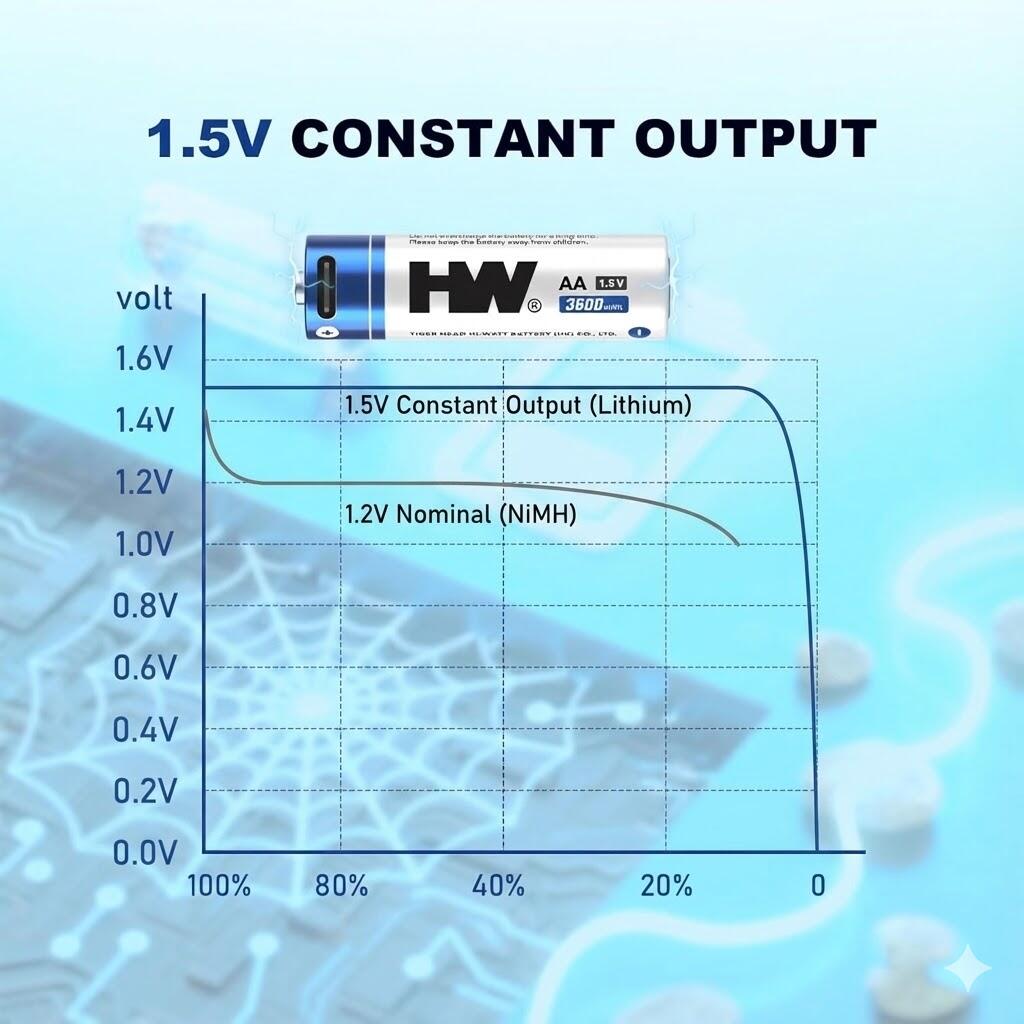உங்களுக்கு அந்த சங்கடமான சூழ்நிலை ஏற்பட்டதா? ஒரு தீவிரமான கேமிங் போரின் நடுவில், ஒரு வினாடி முன்பு முழு பேட்டரி இருப்பதாகக் காட்டிய உங்கள் VR கன்ட்ரோலர், திடீரென செயலிழந்து, உங்கள் போட்டியை இழக்க வைக்கிறது. அல்லது குடும்பத்தின் முக்கியமான கணத்தில், சரியான நேரத்தில் சிறந்த புன்னகையைப் பதிவு செய்ய முயற்சிக்கும் போது உங்கள் கேமரா ஃபிளாஷ் தீர்ந்துவிடுகிறது. உங்கள் பதில் ஆம் என்றால், உங்கள் சாதனத்தில் உள்ள சக்திவாய்ந்த — மற்றும் சிக்கலான — 1.5V மாறாத மின்னழுத்த மீள் சார்ஜ் லித்தியம் பேட்டரிதான் பொதுவாக காரணம்.
இந்த பேட்டரிகள் மின்சக்தி உலகத்தின் எழுச்சி மின்னணுக்களாக உள்ளன, அவற்றின் முக்கிய அம்சமான தொடக்கத்திலிருந்து முடிவு வரை நிலையான 1.5V வெளியீடு மூலம் அதிக செயல்திறன் கொண்ட சாதனங்களின் பயனர்களை விரைவாக வெல்கின்றன. ஆனால் இந்த அம்சம் இரு விளிம்புகள் கொண்ட வாள். இது உச்ச செயல்திறனை வழங்குவதோடு, மின்சாரம் தீர்ந்தவுடன் "திடீர் மரணம்" என்ற தனித்துவமான சவாலையும் கொண்டுவருகிறது.
இந்த கட்டுரை நிலையான மின்னழுத்த அம்சத்திற்குள் ஆழமாகச் செல்கிறது, உங்கள் சாதனங்களை எவ்வாறு உயர்த்துகிறது, ஏன் இது முன்னறிய முடியாத மின்தடைக்கு வழிவகுக்கிறது, மேலும் இதை எவ்வாறு நீங்கள் கையாள முடியும் என்பதை வெளிப்படுத்துகிறது.

பயன்படுத்தப்படும் போது மின்னழுத்தம் மெல்ல குறையும் (எ.கா., 1.5V இலிருந்து 1.2V அல்லது அதற்கும் குறைவாக) பாரம்பரிய கார அல்லது NiMH பேட்டரிகளை விட மாறுபட்டு, 1.5V நிலையான மின்னழுத்த லித்தியம் பேட்டரிகள் வெளியீட்டை 90% க்கும் அதிகமான விநியோக சுழற்சியில் உறுதியான 1.5V ஆக வைத்திருக்க உள்ளமைக்கப்பட்ட ஒரு ஒழுங்குபடுத்தி சுற்று மூலம் செயல்படுகின்றன. இது மூன்று புரட்சிகரமான நன்மைகளை வழங்குகிறது:
மின்சாரம் மற்றும் வோல்டேஜ் அதிகம் தேவைப்படும் சாதனங்களுக்கு, நிலையான வெளியீடு என்பது அவை ஆரம்பம் முதல் இறுதி வரை முழு திறனில் இயங்கும் என்பதை உறுதி செய்கிறது.
கேமரா ஃபிளாஷ்கள்: மறுசுழற்சி நேரம் தொடர்ந்து வேகமாக இருக்கும். பேட்டரி சார்ஜ் குறைய குறைய ஃபிளாஷ் தயாராக ஆக காத்திருக்க வேண்டிய அவசியம் இல்லை, எனவே ஒருபோதும் உங்கள் புகைப்படத்தை தவற விட மாட்டீர்கள்.
VR கேம் கன்ட்ரோலர்கள்: உங்கள் முழு விளையாட்டு அமர்வின் போதும் துல்லியமான டிராக்கிங் மற்றும் உடனடி ஹாப்டிக் ஃபீட்பேக் பராமரிக்கப்படுகிறது. வோல்டேஜ் குறைவதால் ஏற்படும் தாமதம் மற்றும் மந்தநிலையை தூர வைங்கள்.
மோட்டார் வாகன விளையாட்டு பொம்மைகள் & டிரோன்கள்: ஓட்டப்பந்தய காரின் உச்ச வேகமாக இருந்தாலும் அல்லது டிரோனின் தொங்கும் நிலை ஸ்திரத்தன்மையாக இருந்தாலும், கடைசி துளி மின்சாரம் வரை செயல்திறன் உச்சத்தில் இருக்கும்.
பல நவீன மின்னணு சாதனங்களுக்கு கணுக்கட்டான வோல்டேஜ் தேவைகள் உள்ளன, மேலும் வோல்டேஜ் ஒரு குறிப்பிட்ட அளவுக்கு கீழே சென்றவுடன் அவை நிறுத்தப்படும் அல்லது போலி குறைந்த பேட்டரி எச்சரிக்கைகளை அளிக்கும்.
ஸ்மார்ட் லாக்குகள்: மரபுவழி பேட்டரிகளுடன், மின்னழுத்தம் மிகக் குறைவாக இருப்பதால், பேட்டரி 30% அளவு மிச்சமாக இருந்தாலும் ஒரு ஸ்மார்ட் பூட்டு ஒலி எழுப்பத் தொடங்கலாம் அல்லது வேலை செய்ய மறுக்கலாம். மாறாத மின்னழுத்த பேட்டரிகள் இறுதி வரை நம்பகத்தன்மையுடன் இயங்குவதை உறுதி செய்கின்றன.
மருத்துவ கருவிகள்: குளூக்கோஸ் கண்காணிப்பான்கள் மற்றும் இரத்த அழுத்த அளவுமானிகள் போன்ற சாதனங்கள் அவற்றின் அளவீடுகள் தொடர்ந்து துல்லியமாக இருப்பதை உறுதி செய்ய நிலையான மின்னழுத்தத்தை நம்பியுள்ளன.
துல்லிய கருவிகள்: இலக்க அளவுகோல்கள் மற்றும் குற்றலை வெப்பநிலைமானிகள் மின்சார ஏற்ற இறக்கங்களால் ஏற்படும் அளவீட்டுப் பிழைகளைத் தவிர்ப்பதன் மூலம் மாறாத மின்னழுத்தத்திலிருந்து பயன் பெறுகின்றன.
உயர்தர NiMH பேட்டரிகளுடன் ஒப்பிடும்போது மொத்த இயங்கும் நேரம் மணிகளில் ஒப்பிடத்தக்கதாக இருக்கலாம், ஆனால் "செயல்பாட்டு இயங்கும் நேரம்" அல்லது "உயர்தர இயங்கும் நேரம்" குறிப்பிடத்தக்க அளவில் நீட்டிக்கப்படுகிறது. ஒரு மரபுவழி பேட்டரி 10 மணி நேரம் நீடிக்கும், ஆனால் உங்கள் சாதனம் முதல் 5 மணி நேரத்திற்கு மட்டுமே முழு வேகத்தில் இயங்கும் என கற்பனை செய்து பாருங்கள். ஒரு மாறாத மின்னழுத்த பேட்டரி 8 மணி நேரம் நீடிக்கும், ஆனால் அந்த 8 மணி நேரமும் சிறந்த அனுபவத்தை வழங்கும்.
அற்புதமான செயல்திறனை அனுபவிக்கும் போது, மாறாத மின்னழுத்த பேட்டரிகளின் மிகவும் விமர்சிக்கப்படும் அம்சத்தையும் நீங்கள் எதிர்கொள்ள வேண்டும்: அதன் குழப்பும் பேட்டரி மட்ட அறிக்கை.
மின்னணு சாதனங்களின் பெரும்பாலானவை பேட்டரியின் மின்னழுத்தத்தை அளவிடுவதன் மூலம் மீதமுள்ள பேட்டரி ஆயுளை மதிப்பிடுகின்றன. இது ஒரு எளிய, நேரம் சோதிக்கப்பட்ட அமைப்பு: அதிக மின்னழுத்தம் என்றால் முழு பேட்டரி, குறைந்த மின்னழுத்தம் என்றால் பேட்டரி கிட்டத்தட்ட காலியாகிவிட்டது என்று பொருள்.
ஆனால், இந்த இயந்திரம் மாறாத மின்னழுத்த பேட்டரிகளால் முற்றிலும் ஏமாற்றப்படுகிறது. சைக்கிளின் முழு காலகட்டம் முழுவதும் பேட்டரியின் வெளியீடு 1.5V இல் ஸ்திரமாக வைக்கப்படுவதால், சாதனம் பேட்டரி 100% சார்ஜ் செய்யப்பட்டிருப்பதாக நினைக்க ஏமாற்றப்படுகிறது. உள்ளக செல் முற்றிலும் தீர்ந்துவிடும் வரை இது தொடர்கிறது, பின்னர் பாதுகாப்பு சுற்று உடனடியாக மின்சாரத்தை நிறுத்தி, மின்னழுத்தம் 1.5V இல் இருந்து கணம் காணாமல் 0V ஆக சரிகிறது.
இந்த அறிவிக்கப்படாத மின்சார இழப்பு அடிக்கடி "கிளிஃப்-எட்ஜ் டிராப்" என்று அழைக்கப்படுகிறது, மேலும் மிகவும் மோசமான நேரங்களில் இது பெரும் எரிச்சலையும் அபாயத்தையும் ஏற்படுத்தக்கூடும்:
ஒரு புகைப்படக் கலைஞருக்கு: ஆயுள் காலத்தில் ஒருமுறை மட்டுமே நிகழும் நிகழ்வைப் பதிவு செய்யும்போது கேமரா நிறுத்தப்படுகிறது.
ஒரு விளையாட்டு ஆட்டக்காரருக்கு: அவர்கள் புதிய சாதனை படைக்க இருக்கும் சரியான நேரத்தில் கண்ட்ரோலர் இணைப்பு துண்டிக்கப்படுகிறது.
ஸ்மார்ட் ஹோம் பயனருக்கு: இரவில் தாமதமாக வீடு திரும்பும்போது ஸ்மார்ட் லாக் செயலிழந்துவிடுகிறது.
இந்த ஊகிக்க முடியாத தன்மை தான் ஆரம்பகால மாறாத மின்னழுத்த பேட்டரிகள் பயனர்களிடம் ஏற்படுத்திய மிகப்பெரிய எதிர்மறை தாக்கம்.
அதிர்ஷ்டவசமாக, தயாரிப்பாளர்களும் பயனர்களும் இந்த "செயல்திறன் மிருகத்தை" கட்டுப்படுத்தவும், அதை மேலும் கையாளத்தக்கதாக ஆக்கவும் செயலில் வழிகளைக் கண்டுபிடித்து வருகின்றனர்.

“திடீர் மரணம்” என்ற பிரச்சினையை தீர்க்க, சில முன்னணி பேட்டரி பிராண்டுகள் ஒரு புத்திசாலித்தனமான தீர்வை உருவாக்கியுள்ளன. இந்த புதிய தலைமுறை 1.5V லித்தியம் பேட்டரிகள் மேம்படுத்தப்பட்ட ஃபர்ம்வேரைக் கொண்டுள்ளன: சார்ஜ் 5%-10% அளவு மட்டுமே மீதமிருக்கும் போது, பேட்டரி 1.5V இலிருந்து சுமார் 1.1V-1.2V ஆக வெளியீட்டு மின்னழுத்தத்தை நோக்கமாக குறைக்கும் .
பெரும்பாலான சாதங்களில் "குறைந்த பேட்டரி" எச்சரிக்கையை தூண்டுவதற்கு இந்த குறைந்த மின்னழுத்தம் சரியானது, அதே நேரத்தில் குறுகிய காலத்திற்கு இயங்க போதுமான மின்சாரத்தை வழங்குகிறது. இது பயனருக்கு தெளிவான எச்சரிக்கையையும், பேட்டரிகளை மாற்றுவதற்கான அல்லது தங்கள் பணியை முடிப்பதற்கான போதுமான நேரத்தையும் வழங்குகிறது, இது முற்றிலும் முன்னறிவிப்பு பிரச்சினையை தீர்க்கிறது.
முதலில் புதிய மாதிரிகளை தேர்ந்தெடுக்கவும்: சந்தைக்குச் செல்லும்போது, "குறைந்த பேட்டரி எச்சரிக்கை" அல்லது "குறைந்த மின்சார எச்சரிக்கை" போன்ற அம்சங்களைக் குறிப்பிடும் தயாரிப்பு விளக்கங்களைத் தேடவும்.
உங்கள் பயன்பாட்டு சுழற்சியை மதிப்பிடுங்கள்: உங்கள் பொதுவான சாதனங்களில் பேட்டரிகள் எவ்வளவு நேரம் நீடிக்கின்றன என்பதைப் பற்றி உணர்ந்து கொள்ளுங்கள், அவை முற்றிலுமாக செயலிழக்கும் வரை காத்திருப்பதற்கு பதிலாக காலாவதியில் அவற்றை சார்ஜ் செய்யும் பழக்கத்தை ஏற்படுத்திக் கொள்ளுங்கள். உதாரணமாக, உங்கள் கேம் கன்ட்ரோலர் சுமார் 20 மணி நேரம் நீடிக்கும் என்று தெரிந்தால், 15 மணி நேர பயன்பாட்டுக்குப் பிறகு அதை மீண்டும் சார்ஜ் செய்யுங்கள்.
எப்போதும் ஸ்பேர்ஸ் தயாராக வைத்திருங்கள்: கேமராக்கள், ஃபிளாஷ்கள் மற்றும் ஸ்மார்ட் லாக்குகள் போன்ற முக்கியமான சாதனங்களுக்கு, எப்போதும் முழுமையாக சார்ஜ் செய்யப்பட்ட ஸ்பேர் செட்டை தயாராக வைத்திருங்கள்.

1.5V மாறாத மின்னழுத்தம் கொண்ட மீண்டும் சார்ஜ் செய்யக்கூடிய லித்தியம் பேட்டரி என்பது தெளிவாக ஒரு பெரிய தொழில்நுட்ப முன்னேற்றமாகும். உங்கள் சாதனங்களில் இருந்து உச்ச செயல்திறன் மற்றும் தொடர்ச்சியான நிலைத்தன்மையை எதிர்பார்க்கும் பயனர்களுக்கு இது சரியான தீர்வை வழங்குகிறது.
நீங்கள் இதைத் தேர்வு செய்ய வேண்டும் என்றால்:
உங்கள் சாதனங்கள் அதிக மின்சாரத்தை பயன்படுத்துபவை (எ.கா., கேமரா ஃபிளாஷ், VR கன்ட்ரோலர்கள், மோட்டார் வைத்த பொம்மைகள்).
உங்கள் சாதனங்கள் மின்னழுத்தத்திற்கு மிகவும் உணர்திறன் கொண்டவை (எ.கா., ஸ்மார்ட் லாக்குகள், துல்லிய கருவிகள்).
பேட்டரி செயலிழக்கும்போது உங்கள் சாதனத்தின் செயல்திறன் குறைவதை நீங்கள் தாங்க முடியாது.
தேர்வு செய்யும்போது, நீங்கள் முன்னுரிமை கொடுக்க வேண்டியவை:
குறைந்த மின்சார வோல்டேஜ் சரிவு அம்சத்துடன் கூடிய புதிய மாதிரிகள் "திடீர் மரண" எரிச்சலைத் தவிர்க்க.
நம்பகமான பிராண்டுகள், பொதுவாக அதிக நம்பகத்தன்மை வாய்ந்த பாதுகாப்பு சுற்றுகளையும், அதிக துல்லியமான திறன் மதிப்பீடுகளையும் வழங்குகின்றன.
இறுதியில், ஒரு சிறந்த பேட்டரி என்பது உங்கள் தேவைகளுக்கு ஏற்றவாறு பொருத்தமான பேட்டரிதான். மாறாத மின்னழுத்தத்தின் இரு விளிம்பு தன்மையை நீங்கள் புரிந்து கொண்டதால், உங்கள் சாதனங்கள் இருட்டில் உங்களை விட்டுச் செல்லாமல் அவற்றின் முழு திறனையும் வெளிப்படுத்த அனுமதிக்கும் வகையில் நீங்கள் ஒரு தகுந்த தேர்வை செய்யலாம்.
 சூடான செய்திகள்
சூடான செய்திகள்2025-12-10
2025-12-08
2025-11-19
2025-10-19
2025-11-24
2025-10-31